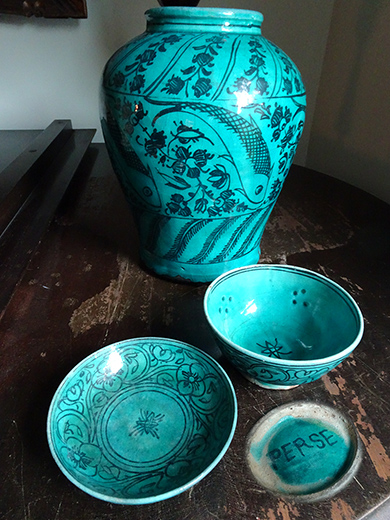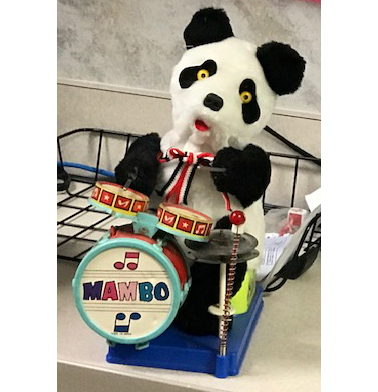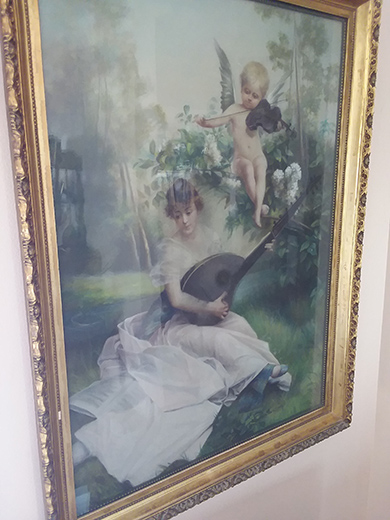 |
|
|||
 |
 |
|||
RINKER ON COLLECTIBLES — Column #1681 Copyright © Harry Rinker, LLC 2019 Questions
and Answers
QUESTION: My wife and I inherited a number of pieces from her parents that had previously belonged to her mother’s rather eccentric great aunt. The aunt collected a lot of Oriental items that have no interest to my wife. Although we disposed of the majority of these over 30 years ago, we kept an 11-inch high vase with a turquoise ground and fish pattern and a 5-inch turquoise bowl and saucer. The vase is unmarked. The bowl and saucer are marked “PERSE.” I suspect the two smaller pieces may not be old since they are marked with the country of origin. In searching the internet, I found a similar piece being sold on eBay as “Iznik Persian Islamic Kashan Blue.” We display the vase beside some other pottery. What additional information can you supply about these items? – BA, New Albany, IN, Email Question 
ANSWER: In 1891, the United States government passed the McKinley Tariff Act. A simplified version of its impact is that goods imported into the United States had to be marked with their country of origin. There were exceptions. In a set, only one piece had to be marked. An “origin” marking on a shipping case often sufficed. Hence, assuming an unmarked piece has to date before 1891 is not necessarily true. Until the middle of the 20th Century, Iran was known as Persia in the Western world. In 1935, the Iranian government asked foreign governments to stop using Persia and replace it with Iran, the name of the country in the Persian language. The change was suggested by the German ambassador when Mohammad-Reza Shah became the nation’s leader in 1941. Symbolically, the name change was meant to demonstrate Iran’s growing independence from British and Russian influence. In order to answer your question, I researched the history of Persian pottery. [Author’s Aside: I write “Rinker on Collectibles” because its questions and topics constantly force me to broaden my antiques and collectibles knowledge.] The quality of Iranian pottery lessened in the 19th century. The Isfahan region introduced a new type of ware with a turquoise ground and black decoration. Cheap foreign imports had a negative impact on the production quality as Persian ceramic makers tried to compete. Conducting a number of “Persian turquoise vase” and “Islamic turquoise vase” internet searches on websites such as eBay, Google, Pinterest, and WorthPoint, it quickly became apparent that there were two quality levels of Persian turquoise ground, black decorated wares from the late 19th and early 20th century – a high aesthetic art pottery level and a mass-produced export/utilitarian level. Comparing the images that accompanied your email with the images I found during my internet search, I concluded your pieces fall into the latter group. There is a third group consisting of British and European manufactured pieces that copied Persian motifs. I dismissed this possibility. Your pieces were manufactured in Persia. While there is a modest collectors’ market for Persian aesthetic art pottery in the United States, there is almost no market for the inexpensive made-for-export or sale-to-tourist pieces. Their secondary market value derives from their conversational and display value. I found an “Antique Persian Ottoman Iznik Kashan Egypt Turquoise Glazed Vase Possibly Seljiuk” listed on eBay for $225.00 or “Best Offer.” The best method to interpret this description is that the seller has absolutely no idea what he/she is selling and is hoping someone who looks at the piece does. The only similarity it has to your pieces is its turquoise ground and black decoration. As a result of my pricing research, the secondary market retail value of your vase is between $95.00 and $115.00. Your bowl and saucer each have a value between $25.00 and $35.00. In a large metropolitan market such as Chicago or New York, the value would increase between 25 and 35 percent. QUESTION: I have a battery-operated Mambo the drumming panda toy. Does it have any value? – CF, Reading, PA, Email Question 
ANSWER: A battery operated toy collecting craze swept the secondary American toy market in the 1990s and early 2000s. These toys, most manufactured in postwar Japan, included action toys such as the panda drummer, cars, figurines, licensed toys, robots, space vehicles, and futuristic vehicles. Many were sold in colorful packaging. In some cases, the package imaging was more exciting than the product inside the box. During the collecting craze, the complete unit consisted of the box and the toy inside. The box often represented 50 percent of the secondary market retail value. A non-working battery-operated toy or one with a rusted battery case, not unusual because children and adults tended not to remove the batteries after playing with the toy, made the toy difficult to sell. WorthPoint listings for “Mambo: Electric Bear Drummer” show an example in working order with box that sold on eBay on September 11, 2018, for $89.00 (a high listing compared to other boxed examples which sold between $25.00 and $45.00) and an example in working order but without the box selling for $19.00 on January 10, 2019. Although there still is a relatively strong market for battery-operated robots and space related vehicles, the secondary market for the remaining battery-operated toys is in the doldrums. Your Mambo toy without its box has a value between $15.00 and $20.00. QUESTION: My wife and I own a framed pastel portrait measuring approximately 3 feet wide by 4 feet tall. It pictures a seated woman playing a long-neck lute or guitar in an idyllic garden setting. A winged putti (nymph) playing fiddle rests in a flowering bush located behind her left shoulder. A paper label on the back reads: “THE J. B. MURPHY CO., / Genuine Hand Made Crayon and Pastèlle Portraits / Fine Pictures…All Kinds of Frames / WATERTOWN, WISCONSIN.” What information can you provide about our pastel portrait and what value should we place on it for insurance purposes? – MH, Watertown, WI, Email Question 
ANSWER: Local/regional art is a subcategory in the art field. Artwork, especially by local artists, that remains in the area where it originated often has a higher value in that area than outside the area. This is the case with your pastel drawing. The Watertown Historical Society’s website has a detailed history of Straw & Goodrow/ J. B. Murphy Co./ James B. Murphy / and Nicholas Murph. For the detailed history of these interlocking companies, see: www.watertownhistory.org/articles/murphy_jb.htm. The J. B. Murphy Co. was incorporated in 1908. The company sold wallpaper and painting supplies. Murphy was trained as a painter. In 1914, the J. B. Murphy Company moved from 118-120 Main Street to 111 Main Street, its new label reflecting the change of address. J. B. Murphy died on May 9, 1915. Inspirational and landscape pastel painting was extremely popular in the early 20th century, especially in the Midwest. Although it is possible that Murphy painted your pastel, it also is likely that he sold the work of other pastel painters in the area. A search of askart.com and other internet websites produced no listings for pastels by J. B. Murphy. I recommend taking your pastel to a local art museum to see what additional information it may have on pastel paintings done by artists from the area. The subject matter, a typical theme from the early 20th century, is out-of-date today. As such, the pastel’s decorative value is minimized. As stated earlier, the value of the pastel is local. In Wisconsin, the pastel has a value between $250.00 and $350.00. Elsewhere, the value drops by over half. Given this, it is not necessary to secure additional Fine Art insurance for your pastel. It will be covered in your regular homeowner’s policy. One final note: The images that accompanied your letter suggest there is a piece of glass covering the pastel. If true, this presents a clear and present danger. Pastel and charcoal have a bad habit of sticking to glass. Take the pastel to a frame shop. If the pastel can be successfully removed without damage (if it is stuck to the glass, do nothing), have it reframed with a thin strip of acid free mat placed in each rabbet of the frame. This will create a space between the glass and the pastel, thus protecting it. Harry L. Rinker welcomes questions from readers about
collectibles, those mass-produced items from the twentieth and twenty-first centuries.
Selected letters will be answered in this column.
Harry cannot provide personal answers.
Photos and other material submitted cannot be
returned.
Send your questions to: Rinker on Collectibles, 5955 Mill
Point Court SE, Kentwood, MI 49512.
You also can e-mail your questions to
harrylrinker@aol.com.
Only e-mails containing a full name and mailing address
will be considered.
|
||||